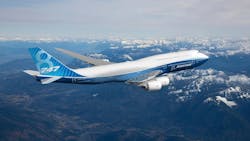Air Force picks Sierra Nevada to build command and control aircraft for nuclear war secure communications
HANSCOM AIR FORCE BASE, Mass. – The U.S. Air Force is choosing Sierra Nevada Corp. in Englewood, Colo., to design and build a new command and control aircraft to replace the service's E-4B National Airborne Operations Center (NAOC).
Officials of the Air Force Life cycle Management Center at Hanscom Air Force Base, Mass., announced a $13.1 billion contract to Sierra Nevada on Friday for the Survivable Airborne Operations Center (SAOC) weapon system.
The SAOC aircraft will offer survivable command, control and communications in case of national emergency or destruction of ground command control centers, such as is likely during an all-out nuclear war. The aircraft will carry the U.S. president, secretary of defense and the Joint Chiefs of Staff in the event of a national emergency.
The legacy E-4B fleet consists of four modified Boeing 747 jumbo jets. Although it's not clear what the new SAOC aircraft will be, military leaders want a commercially derived aircraft hardened to protect against nuclear and electromagnetic effects and modified with aerial refueling capability.
The new SAOC, which should be operational by the 2030s, is to direct U.S. forces, execute emergency war orders, and coordinate actions by civil authorities in case of a nuclear emergency. Additionally, the SAOC will provide outside-U.S. travel support for the U.S. secretary of defense and his staff to maintain national military command and control connectivity.
The SAOC will replace the ageing E-4B fleet because the 1970s-era aircraft is approaching end of its service life. The SAOC will be on a new cost-effective aircraft with modern communications subsystem, networks subsystem, and advanced command and control subsystems.
Early Air Force requirements strongly suggested a large four-engine commercial jet to host the SAOC. That would narrow-down the possible aircraft to the Boeing 748-8, introduced in 2011, and the Airbus A380, introduced in 2005.
The problem with these aircraft is neither one is in production today. Airbus ended production of the A380 in 2021, and Boeing phased-out the 747-8 in 2023. This may require use of smaller efficient twin-engine commercial jets for the SAOC such as the Airbus A350 or Boeing 787.
The SAOC aircraft will help direct U.S. forces, carry out emergency war orders, and coordinate civil actions. The new plane will have a wide variety of secure communications and networking, high-speed computers, radiation-hardened electronic components, and the ability to resist the effects of electromagnetic pulse (EMP).
On this contract Sierra Nevada will do the work in Englewood, Colo.; Sparks, Nev.; Beavercreek, and Vandalia, Ohio, and should be finished by July 2036. For more information contact Sierra Nevada Corp. online at www.sncorp.com.
About the Author
John Keller
Editor-in-Chief
John Keller is the Editor-in-Chief, Military & Aerospace Electronics Magazine--provides extensive coverage and analysis of enabling electronics and optoelectronic technologies in military, space and commercial aviation applications. John has been a member of the Military & Aerospace Electronics staff since 1989 and chief editor since 1995.
